文章
权问薇
2018年02月04日

绿萝
操作方法:
1、剪下一段绿萝枝条,最好挑选带有气生根的,这样绿萝更容易生根,成活率也高。
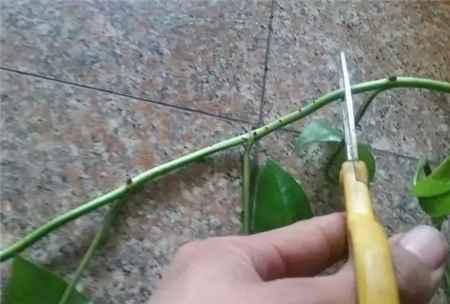
2、把剪下的绿萝再分成小段,每段保留一片叶就行。

3、把绿萝插到准备好的花盆里,土不要覆盖的太厚。然后浇一次水,放在通风的位置养护。

4、等到绿萝开始生长,长出新叶的时候,可以把绿萝搬到南阳台,晒一晒太阳,用不了两个月,就能长成一盆全新的绿萝!

长寿花
操作方法:
1、剪下长寿花的枝条,分成小段,每段只留一对叶子就可以,否则叶片多了会增加养分流失,影响生根速度。
2、把剪好的长寿枝条插到土里,长寿花扦插对土壤要求不高,用普通园土加点沙子就行。

3、等到长寿花长出新叶之后,就可以搬到阳台,多晒太阳,每周浇1次水,很快就能长成一盆大长寿花了!
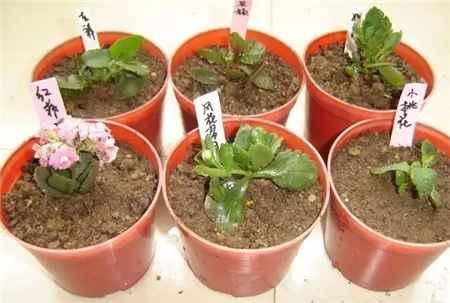
发财树
操作方法:
1、剪下比较健壮的发财树枝,最好是一年以上的木质枝条,每个扦插的枝条保留2~4片叶子就可以。
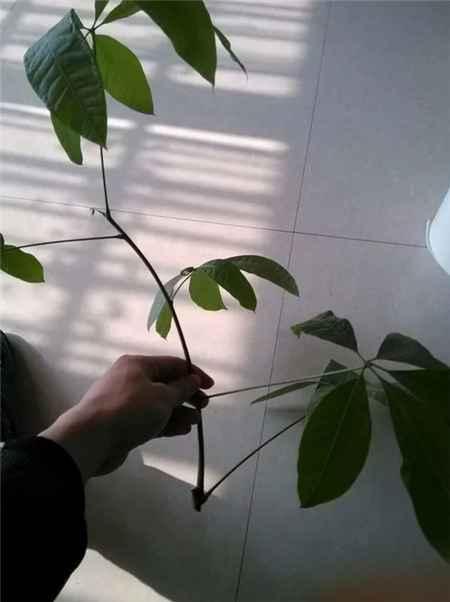
2、把发财树枝条插到准备好的沙子里,浇一遍水,放在阴凉的地方养护,之后每天都喷喷水,保持河沙湿润。

3、大概一个月以后,发财树就能生根了,这时候再移栽到花盆里就可以了。
天竺葵
操作方法:
1、把天竺葵枝条剪成小段,每段10厘米左右,留1~2片叶子就足够了。剪下来不要 急着插,先放到阴凉的地方晾1天。

2、一天后,准备好河沙,把天竺葵枝条插到沙子里,浇水浇透,然后每天给天竺葵喷喷水。
3、大概15~20天,天竺葵就能长出新根了,生根后移栽到大花盆里养护就可以了。
月季
操作方法:
1、扦插月季最好选生长1年以上的枝条,用剪刀分成5~8厘米的小段,剪掉残花,保留叶子。

2、把月季花枝条放进塑料瓶里,瓶底倒点水,不需要太多,0.5~1厘米左右就可以了。
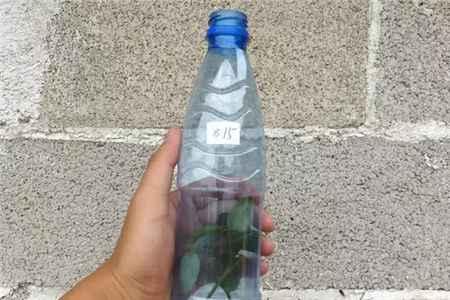
3、把塑料瓶放在窗台上,接受光照,注意保持瓶底始终有水。这样大概2周后就能生根了,生根后就可以移栽到花盆里了!
各种常见花的扦插技巧就说到这了,是不是很容易操作呢?家里比较暖和的花友现在就可以试试!
操作方法:
1、剪下一段绿萝枝条,最好挑选带有气生根的,这样绿萝更容易生根,成活率也高。

2、把剪下的绿萝再分成小段,每段保留一片叶就行。

3、把绿萝插到准备好的花盆里,土不要覆盖的太厚。然后浇一次水,放在通风的位置养护。

4、等到绿萝开始生长,长出新叶的时候,可以把绿萝搬到南阳台,晒一晒太阳,用不了两个月,就能长成一盆全新的绿萝!

长寿花
操作方法:
1、剪下长寿花的枝条,分成小段,每段只留一对叶子就可以,否则叶片多了会增加养分流失,影响生根速度。
2、把剪好的长寿枝条插到土里,长寿花扦插对土壤要求不高,用普通园土加点沙子就行。

3、等到长寿花长出新叶之后,就可以搬到阳台,多晒太阳,每周浇1次水,很快就能长成一盆大长寿花了!

发财树
操作方法:
1、剪下比较健壮的发财树枝,最好是一年以上的木质枝条,每个扦插的枝条保留2~4片叶子就可以。

2、把发财树枝条插到准备好的沙子里,浇一遍水,放在阴凉的地方养护,之后每天都喷喷水,保持河沙湿润。

3、大概一个月以后,发财树就能生根了,这时候再移栽到花盆里就可以了。
天竺葵
操作方法:
1、把天竺葵枝条剪成小段,每段10厘米左右,留1~2片叶子就足够了。剪下来不要 急着插,先放到阴凉的地方晾1天。

2、一天后,准备好河沙,把天竺葵枝条插到沙子里,浇水浇透,然后每天给天竺葵喷喷水。
3、大概15~20天,天竺葵就能长出新根了,生根后移栽到大花盆里养护就可以了。
月季
操作方法:
1、扦插月季最好选生长1年以上的枝条,用剪刀分成5~8厘米的小段,剪掉残花,保留叶子。

2、把月季花枝条放进塑料瓶里,瓶底倒点水,不需要太多,0.5~1厘米左右就可以了。

3、把塑料瓶放在窗台上,接受光照,注意保持瓶底始终有水。这样大概2周后就能生根了,生根后就可以移栽到花盆里了!
各种常见花的扦插技巧就说到这了,是不是很容易操作呢?家里比较暖和的花友现在就可以试试!
2
3
文章
Miss Chen
2018年02月04日

Description: This perennial wildflower produces ascending stems 2-6" long that branch occasionally. These stems are surrounded by finger-like leaves that are ascending to widely spreading; the stems are light green, glabrous, and succulent. The leaves are up to 3" long, terete in cross-section, and succulent; they are green to blue-gray and glabrous. Occasionally, the upper stems produce cymes of flowers on long slender stalks (peduncles); these stalks are 4-10" long. Each cyme is open and widely spreading (up to 12" across); its branching structure is dichotomous or trichotomous. Pairs of tiny lanceolate bracts occur along the branches of each cyme. Usually, each cyme has about 5-50 flowers, although poorly developed cymes may have fewer flowers than this. Each flower spans about 1" across, consisting of 5 petals, 2 sepals, 30-45 stamens, and a pistil with a single slender style. The widely spreading petals are deep rose pink and well-rounded, while the sepals are light green to membranous and ovate to oval-orbicular in shape. The petals are much longer than the sepals. The style of each flower is about twice the length of the stamens; there is a knobby stigma at the end of the style.
The blooming period occurs intermittently during the summer for 1-3 months; sometimes several flowers bloom at the same time. The flowers open on sunny days during the early afternoon for about 2 hours; individual flowers last only a single day and they lack fragrance. Each fertile flower is replaced by a seed capsule that is up to 1/3" (8 mm.) in length; it is ovoid-globoid in shape, and divides into 3 parts to release the tiny seeds inside. Individual seeds are about 1 mm. in length; they are reniform and flattened in shape with smooth outer surfaces. The seeds are small enough to be blown about by the wind. The root system consists of a thickened taproot with fibrous secondary roots.
Cultivation: The preference is full sun, dry conditions, and soil that is rocky, gravelly, or sandy. This species is adaptable to a sunny rock garden and it is intolerant of competition from tall aggressive plants.
Range & Habitat: Large-Flowered Rock Pink has been found in only a single county in SW Illinois, where it is extremely rare (see Distribution Map). This native species is state-listed as endangered. Large-Flowered Rock Pink occurs primarily in the southern plains; Illinois lies at the NE range limit for this species. In Illinois, habitats are restricted to sunny ledges of sandstone cliffs. In others states, habitats include rocky glades, hill prairies, and barren upland savannas. Occasionally, this species is cultivated in gardens because of the attractive flowers and foliage.

Faunal Associations: Very little is known about floral-faunal relationships for this species. The webmaster observed a medium-sized dark bee collecting pollen from the flowers while they were being photographed.
Photographic Location: A flower garden at the Arboretum of the University of Illinois in Urbana, Illinois.
Comments: Other common names include Large Flower-of-an-Hour and Fame-Flower. The flowers are beautiful, but short-lived. Two other species in this genus that occur in Illinois are Phemeranthus parviflorus (Small-Flowered Rock Pink) and Phemeranthus rugospermus (Sand Rock Pink). The flowers of these latter species are smaller in size (less than ¾") and the styles of their flowers are about the same length as the stamens. In contrast, Large-Flowered Rock Pink has flowers about 1" across and the styles of its flowers are about twice the length of the stamens. Without observing the flowers, it is very difficult to distinguish these species. Interestingly, each of these species blooms during a different time of the day: Small-Flowered Rock Pink blooms during the morning, Sand Rock Pink blooms during the late afternoon, while Large-Flowered Rock Pink blooms during the early afternoon. A scientific synonym of Large-Flowered Rock Pink is Talinum calycinum.
The blooming period occurs intermittently during the summer for 1-3 months; sometimes several flowers bloom at the same time. The flowers open on sunny days during the early afternoon for about 2 hours; individual flowers last only a single day and they lack fragrance. Each fertile flower is replaced by a seed capsule that is up to 1/3" (8 mm.) in length; it is ovoid-globoid in shape, and divides into 3 parts to release the tiny seeds inside. Individual seeds are about 1 mm. in length; they are reniform and flattened in shape with smooth outer surfaces. The seeds are small enough to be blown about by the wind. The root system consists of a thickened taproot with fibrous secondary roots.
Cultivation: The preference is full sun, dry conditions, and soil that is rocky, gravelly, or sandy. This species is adaptable to a sunny rock garden and it is intolerant of competition from tall aggressive plants.
Range & Habitat: Large-Flowered Rock Pink has been found in only a single county in SW Illinois, where it is extremely rare (see Distribution Map). This native species is state-listed as endangered. Large-Flowered Rock Pink occurs primarily in the southern plains; Illinois lies at the NE range limit for this species. In Illinois, habitats are restricted to sunny ledges of sandstone cliffs. In others states, habitats include rocky glades, hill prairies, and barren upland savannas. Occasionally, this species is cultivated in gardens because of the attractive flowers and foliage.

Faunal Associations: Very little is known about floral-faunal relationships for this species. The webmaster observed a medium-sized dark bee collecting pollen from the flowers while they were being photographed.
Photographic Location: A flower garden at the Arboretum of the University of Illinois in Urbana, Illinois.
Comments: Other common names include Large Flower-of-an-Hour and Fame-Flower. The flowers are beautiful, but short-lived. Two other species in this genus that occur in Illinois are Phemeranthus parviflorus (Small-Flowered Rock Pink) and Phemeranthus rugospermus (Sand Rock Pink). The flowers of these latter species are smaller in size (less than ¾") and the styles of their flowers are about the same length as the stamens. In contrast, Large-Flowered Rock Pink has flowers about 1" across and the styles of its flowers are about twice the length of the stamens. Without observing the flowers, it is very difficult to distinguish these species. Interestingly, each of these species blooms during a different time of the day: Small-Flowered Rock Pink blooms during the morning, Sand Rock Pink blooms during the late afternoon, while Large-Flowered Rock Pink blooms during the early afternoon. A scientific synonym of Large-Flowered Rock Pink is Talinum calycinum.
0
0
文章
Miss Chen
2018年02月04日

Description: This herbaceous perennial plant is 2-3½' tall, branching sparingly. The slender stems are round and hairless. The alternate compound leaves occur sparingly along the stems; they are doubly pinnate, and about 8" long and half as wide. The slender leaflets are up to 1/8" (3 mm.) across. They often have 1-3 lobes, but their margins are smooth. The upper stems terminate in compound umbels with small white flowers. A typical umbel is about 6" across and has about 12 umbellets; these umbellets are loosely arranged, rather than compressed together. An umbellet is about 1" across and has 7-21 flowers.
Each flower is about 1/8" (3 mm.) across, with 5 white petals that are notched in the middle, and 5 green sepals that are small and triangular. There are also up to 5 white stamens with 5 white anthers that are potentially observable; frequently, there appears to be fewer than 5 of these reproductive structures because they are fragile and short-lived. The blooming period occurs during early summer and lasts about 2 weeks. There is no noticeable floral scent. The root system is tuberous, which enables this plant to develop quickly during the spring and early summer. After blooming, it quickly fades away and becomes dormant for the rest of the year.
Cultivation: The preference is light shade to full sun, and moist to slightly dry conditions. Wild Dill often grows in soil that is rich and loamy; it also tolerates some clay or rocky material. This plant should be cultivated more often in wildflower gardens.

Range & Habitat: The native Wild Dill occurs occasionally in NE and central Illinois, but it is rare or absent elsewhere (see Distribution Map). Habitats include mesic black soil prairies, openings or edges near woodlands, areas along woodland paths, thickets, limestone glades, and bluffs. It often grows in grassy areas, but is easy to overlook, except during the short blooming period. This plant is more typical of high quality habitats than disturbed areas.
Faunal Associations: The nectar of the flowers attracts many small bees, wasps, flies, and beetles. Among the flies, are such visitors as biting midges, Syrphid flies, thick-headed flies, Tachinid flies, flesh flies, bottle flies, Muscid flies, Chloropid flies, and others. Among the wasps, are such unusual visitors as cuckoo wasps and various parasitoid wasps, including the Chalcid, Perilampid, Eucoilid, Figitid, and Ichneumonid wasps. Little is known about this plant's relationship to mammalian herbivores; because the foliage is not known to be toxic, it is probably consumed by them occasionally.

Photographic Location: The photographs were taken at Meadowbrook Park in Urbana, Illinois, and at Prospect Cemetery Prairie in Ford County, Illinois.
Comments: This is an ethereal plant that is lovely while in bloom; unfortunately, this doesn't last very long. From a distance, Wild Dill may appear to be an early blooming Daucus carota (Wild Carrot), but closer inspection of the foliage and flowers will reveal significant differences between these two plants. What sets Wild Dill apart from many other white-flowered members of the Carrot family is the season of bloom (early summer) and the slender, delicate leaves (not wider than 1/8" across). Also, it should not be confused with Anethum graveolens (Cultivated Dill); this familiar annual herb from the Old World has yellow flowers. Another common name for Perideridia americana is 'Thicket Parsley.'
Each flower is about 1/8" (3 mm.) across, with 5 white petals that are notched in the middle, and 5 green sepals that are small and triangular. There are also up to 5 white stamens with 5 white anthers that are potentially observable; frequently, there appears to be fewer than 5 of these reproductive structures because they are fragile and short-lived. The blooming period occurs during early summer and lasts about 2 weeks. There is no noticeable floral scent. The root system is tuberous, which enables this plant to develop quickly during the spring and early summer. After blooming, it quickly fades away and becomes dormant for the rest of the year.
Cultivation: The preference is light shade to full sun, and moist to slightly dry conditions. Wild Dill often grows in soil that is rich and loamy; it also tolerates some clay or rocky material. This plant should be cultivated more often in wildflower gardens.

Range & Habitat: The native Wild Dill occurs occasionally in NE and central Illinois, but it is rare or absent elsewhere (see Distribution Map). Habitats include mesic black soil prairies, openings or edges near woodlands, areas along woodland paths, thickets, limestone glades, and bluffs. It often grows in grassy areas, but is easy to overlook, except during the short blooming period. This plant is more typical of high quality habitats than disturbed areas.
Faunal Associations: The nectar of the flowers attracts many small bees, wasps, flies, and beetles. Among the flies, are such visitors as biting midges, Syrphid flies, thick-headed flies, Tachinid flies, flesh flies, bottle flies, Muscid flies, Chloropid flies, and others. Among the wasps, are such unusual visitors as cuckoo wasps and various parasitoid wasps, including the Chalcid, Perilampid, Eucoilid, Figitid, and Ichneumonid wasps. Little is known about this plant's relationship to mammalian herbivores; because the foliage is not known to be toxic, it is probably consumed by them occasionally.

Photographic Location: The photographs were taken at Meadowbrook Park in Urbana, Illinois, and at Prospect Cemetery Prairie in Ford County, Illinois.
Comments: This is an ethereal plant that is lovely while in bloom; unfortunately, this doesn't last very long. From a distance, Wild Dill may appear to be an early blooming Daucus carota (Wild Carrot), but closer inspection of the foliage and flowers will reveal significant differences between these two plants. What sets Wild Dill apart from many other white-flowered members of the Carrot family is the season of bloom (early summer) and the slender, delicate leaves (not wider than 1/8" across). Also, it should not be confused with Anethum graveolens (Cultivated Dill); this familiar annual herb from the Old World has yellow flowers. Another common name for Perideridia americana is 'Thicket Parsley.'
0
0
文章
Miss Chen
2018年02月04日

Description: This perennial plant is 2-3' tall, forming one or more unbranched flowering stalks. The central stem is light green, glabrous, and terete. Pairs of opposite leaves develop along the lower half of this stem; they are up to 5" long and 2" across, deltate-ovate to oblong-lanceolate in shape, and smooth to slightly toothed along their margins. Between the leaves on the lower stem and the inflorescence, the central stem is usually naked; sometimes pairs of small narrow leaves (1" long or less) can be found along the upper stem that resemble bracts. The upper surface of the leaves is medium to dark green and glabrous, while the lower surface is pale green and glabrous.
Two Plants in Bloom
The inflorescence consists of a cylindrical panicle of flowers about ½-1½' in length. Within this inflorescence, the flowers are clustered together at intervals in pseudo-whorls (about 6-12 flowers per pseudo-whorl). Individual flowers are about ¾-1" long and across, consisting of a funnel-shaped white corolla that flares outward into 5 rounded lobes, a small green calyx with 5 ovate teeth, 5 stamens (one of them sterile), and a pistil with a single style. Tiny glandular hairs occur along the outside and inside of the corolla. The peduncles and pedicels of the flowers are either glabrous or glandular-hairy. The blooming period occurs from late spring to early summer and lasts about 3 weeks. The flowers are replaced by ovoid seed capsules about 1/3" long; the latter eventually split open to release numerous small seeds. The root system consists of a crown with fibrous roots. Low basal leaves are usually present during winter dormancy.
Cultivation: The preference is full or partial sun, mesic to dry conditions, and loamy or rocky soil. Well-drained conditions are required to prevent root rot.

Range & Habitat: Trumpet Penstemon is uncommon in southern Illinois, and rare or absent in the rest of the state (see Distribution Map). Illinois lies near the northeast range-limit of this species. Habitats include meadows and openings in upland woodlands, oak savannas, thinly wooded bluffs, prairies, limestone glades, and prairie remnants along railroads.
Faunal Associations: The nectar and pollen of the flowers attract long-tongued bees primarily: bumblebees, Anthophorine bees (Anthophora spp.), a Mason bee (Osmia distincta), and a wasp (Pseudomasaris occidentalis). The last two insects are oligoleges of Penstemon spp. (Penstemons). Other floral visitors include Green Metallic bees (collect pollen only) Swallowtail butterflies (suck nectar only), and the Ruby-Throated Hummingbird (suck nectar only). Moth caterpillars that feed on Penstemons include Elaphria chalcedonia (Chalcedony Midget), Oncocnemis saudersiana (Saunder's Oncocnemis), and Pyrrhia exprimens (Purple-Lined Sallow). Mammalian herbivores apparently make little use of the foliage as a food source.

Photographic Location: A prairie in Fayette County, Illinois. The photographs were taken by Keith & Patty Horn (Copyright © 2010).
Comments: Trumpet Penstemon is an elegant wildflower with an unusually long and slender inflorescence. In addition to these characteristics of its inflorescence, it differs from other Penstemon spp. (Penstemons) by the shape of its flowers (narrow and funnel-shaped at the base, rather than swollen), the large size and similarity of its corolla lobes, the lack of conspicuous leaves between the inflorescence and the leaves of the lower stem, the presence of tiny glandular hairs within its corolla, and the lack of hairs on its leaves and central stalk. Sometimes the scientific name of this species is spelled Penstemon tubiflorus (see Britton & Brown, 1913/1970).
Two Plants in Bloom
The inflorescence consists of a cylindrical panicle of flowers about ½-1½' in length. Within this inflorescence, the flowers are clustered together at intervals in pseudo-whorls (about 6-12 flowers per pseudo-whorl). Individual flowers are about ¾-1" long and across, consisting of a funnel-shaped white corolla that flares outward into 5 rounded lobes, a small green calyx with 5 ovate teeth, 5 stamens (one of them sterile), and a pistil with a single style. Tiny glandular hairs occur along the outside and inside of the corolla. The peduncles and pedicels of the flowers are either glabrous or glandular-hairy. The blooming period occurs from late spring to early summer and lasts about 3 weeks. The flowers are replaced by ovoid seed capsules about 1/3" long; the latter eventually split open to release numerous small seeds. The root system consists of a crown with fibrous roots. Low basal leaves are usually present during winter dormancy.
Cultivation: The preference is full or partial sun, mesic to dry conditions, and loamy or rocky soil. Well-drained conditions are required to prevent root rot.

Range & Habitat: Trumpet Penstemon is uncommon in southern Illinois, and rare or absent in the rest of the state (see Distribution Map). Illinois lies near the northeast range-limit of this species. Habitats include meadows and openings in upland woodlands, oak savannas, thinly wooded bluffs, prairies, limestone glades, and prairie remnants along railroads.
Faunal Associations: The nectar and pollen of the flowers attract long-tongued bees primarily: bumblebees, Anthophorine bees (Anthophora spp.), a Mason bee (Osmia distincta), and a wasp (Pseudomasaris occidentalis). The last two insects are oligoleges of Penstemon spp. (Penstemons). Other floral visitors include Green Metallic bees (collect pollen only) Swallowtail butterflies (suck nectar only), and the Ruby-Throated Hummingbird (suck nectar only). Moth caterpillars that feed on Penstemons include Elaphria chalcedonia (Chalcedony Midget), Oncocnemis saudersiana (Saunder's Oncocnemis), and Pyrrhia exprimens (Purple-Lined Sallow). Mammalian herbivores apparently make little use of the foliage as a food source.

Photographic Location: A prairie in Fayette County, Illinois. The photographs were taken by Keith & Patty Horn (Copyright © 2010).
Comments: Trumpet Penstemon is an elegant wildflower with an unusually long and slender inflorescence. In addition to these characteristics of its inflorescence, it differs from other Penstemon spp. (Penstemons) by the shape of its flowers (narrow and funnel-shaped at the base, rather than swollen), the large size and similarity of its corolla lobes, the lack of conspicuous leaves between the inflorescence and the leaves of the lower stem, the presence of tiny glandular hairs within its corolla, and the lack of hairs on its leaves and central stalk. Sometimes the scientific name of this species is spelled Penstemon tubiflorus (see Britton & Brown, 1913/1970).
0
0
文章
权问薇
2018年02月04日


一.原因分析
1.给水次数及水量过多。因为给水过多,造成新叶泛黄,但老叶子没有什么明显的变化。
2.缺水。有水量过多的情况不可避免地也会有缺水的情况,因水不够会引起下面的老叶子黄掉,时间长了会整株叶子黄掉从而干枯死掉。
3.肥料过多。肥料放置过多会使新叶子表面坑坑洼洼生长不平。
4.缺肥料。不按时施肥会让植株缺少营养,新叶子和嫩茎会黄掉,时间长了会使植株死掉。
5.植株缺铁。室内种植会让土壤不稳定,会随时变化,会使叶子呈现不同程度的干瘪黄掉。

二.解决办法
1.浇水问题:要按时浇水,控制浇水量和浇水的次数来避免浇水过多或植株缺水引起的植株叶子干瘪。
2.肥料问题:要按时按量进行进行追肥,避免一次性肥料过多让植株发育畸形或长时间不施肥让植株缺失营养而引起的叶子泛黄的情况。
3植株缺铁问题:按比例用7份饼肥和5份硫酸亚铁一起和水配成稀释液浇到植株上,可解决这个问题。
总结:要在养护上多加细心,充分了解其习性以及生长环境,既要保持盆栽内的水分又要适当地给予阳光照射,并要在高温时注意给它通风遮挡阳光。此外还要定期修剪植株,给盆栽内的土进行松土透气等。

0
0
文章
Miss Chen
2018年02月03日

Description: This perennial wildflower is 1–2½' tall and unbranched. The erect central stem is pale green and terete; it is covered with short pubescence and scattered long hairs. The opposite leaves are up to 3¼" long and ¾" across; they are linear-lanceolate or lanceolate-oblong, pale green, and entire (toothless) to slightly dentate along their margins (if teeth are present, they are small and widely spaced). Both the lower and upper surfaces of the leaves are short-pubescent. The central stem terminates in a panicle of flowers that is 4-10" long; this panicle is taller than it is wide. Individual flowers are about ¾" long, consisting of a white corolla, a short calyx with 5 teeth, 4 stamens, and a pistil with a single style. The corolla is tubular-trumpet shaped, becoming broader toward its upper and lower lips. The upper lip has 2 short rounded lobes, while the lower lip has 3 short rounded lobes. The lower lip projects outward to a greater extent than the upper lip.
Panicle of Flowers
Along the bottom of the corolla's interior, there are 3 faint purple veins and a pair of low ridges. Toward the throat of the corolla on the bottom, there is a narrow patch of yellow hairs. The exterior of the corolla is slightly pubescent. The calyx is light green and pubescent. The stalks of the inflorescence and pedicels of the flowers are also light green (sometimes with purplish tints) and pubescent. The blooming period occurs from mid-spring to early summer, lasting about 3 weeks for a colony of plants. There is no noticeable floral scent. Afterwards, the flowers are replaced by ovoid seed capsules about ¼" long or slightly longer. Each capsule contains numerous tiny seeds. Individual seeds are about 0.5 mm. in length or a little longer, triangular-ovoid and somewhat flattened in shape, and dark brown or black. Eventually, the capsules split in two to release their seeds; these seeds are small enough to be carried about by the wind. The root system consists of a crown with fibrous roots or a taproot.

Cultivation: Full to partial sun and mesic to dry conditions are preferred. Different kinds of soil are tolerated, including those containing clay-loam, sand, or rocky material. Reduced soil fertility is beneficial, because this reduces competition from taller and more aggressive plants.
Range & Habitat: The native Pale Penstemon is occasional throughout Illinois, except in east-central and some northern areas of the state, where it is uncommon or absent (see Distribution Map). Habitats include dry rocky woodlands, hill prairies, dry-mesic railroad prairies, sandstone and limestone glades, upland savannas, thinly wooded bluffs, rocky cliffs, and abandoned fields. Occasional wildfires are beneficial in maintaining populations of this species, particularly in wooded habitats.

Faunal Associations: The flowers of Pale Penstemon are cross-pollinated primarily by long-tongued bees, including honeybees, bumblebees, little carpenter bees (Ceratina spp.), and mason bees (Hoplitis spp., Osmia spp.); see Crosswhite & Crosswhite (1966) and Clinebell & Bernhardt (1998). A mason bee, Osmia distincta, is an oligolege (specialist pollinator) of Penstemon spp. These insects obtain nectar and/or pollen from the flowers. Short-tongued Halictid bees also visit the flowers for pollen. Other insects feed destructively on the foliage, flowers, or fruits of Penstemon spp. These species include the caterpillars of such moths as the Chalcedony Midget (Elaphria chalcedonia), Saunder's Sallow Moth (Sympistis saundersiana), and a stem-gall forming Gracillariid moth (Caloptilia murtfeldtella); see Covell (1984/2005), Panzer et al. (2006), and the Microleps website (2010). A polyphagous aphid, Abstrusomyzus phloxae, sucks sap from these plants (Blackman & Eastop, 2013). Generally, most mammalian herbivores appear to avoid the consumption of the foliage of these plants. For example, Georgia (1913) has stated that the foliage of Foxglove Penstemon (Penstemon digitalis) is rejected by cattle because it is unwholesome and bitter-tasting. However, Lindroth & Batzli (1984) have found that the young shoots of this same plant are readily eaten by the Meadow Vole (Microtus pennsylvanicus) in prairies.

Photographic Location: A small meadow at Busey Woods in Urbana, Illinois.
Comments: Pale Penstemon is a reasonably attractive wildflower that blooms a little earlier than other Penstemon spp. It can be distinguished from these other species by its evenly pubescent foliage and the following characteristics of its corolla: 1) the lower interior surface is distinctively ridged, rather than flat or concave, 2) the lower lip extends significantly beyond the upper lip, and 3) the exterior is white, rather than pale rose-purple. Overall, Pale Penstemon is more dainty in appearance than its taller and more aggressive cousin, Foxglove Penstemon (Penstemon digitalis). Another common name of Penstemon pallidus is Pale Beardtongue (or Beardstongue), which refers to the yellow hairs that line the throat of the corolla.
Panicle of Flowers
Along the bottom of the corolla's interior, there are 3 faint purple veins and a pair of low ridges. Toward the throat of the corolla on the bottom, there is a narrow patch of yellow hairs. The exterior of the corolla is slightly pubescent. The calyx is light green and pubescent. The stalks of the inflorescence and pedicels of the flowers are also light green (sometimes with purplish tints) and pubescent. The blooming period occurs from mid-spring to early summer, lasting about 3 weeks for a colony of plants. There is no noticeable floral scent. Afterwards, the flowers are replaced by ovoid seed capsules about ¼" long or slightly longer. Each capsule contains numerous tiny seeds. Individual seeds are about 0.5 mm. in length or a little longer, triangular-ovoid and somewhat flattened in shape, and dark brown or black. Eventually, the capsules split in two to release their seeds; these seeds are small enough to be carried about by the wind. The root system consists of a crown with fibrous roots or a taproot.

Cultivation: Full to partial sun and mesic to dry conditions are preferred. Different kinds of soil are tolerated, including those containing clay-loam, sand, or rocky material. Reduced soil fertility is beneficial, because this reduces competition from taller and more aggressive plants.
Range & Habitat: The native Pale Penstemon is occasional throughout Illinois, except in east-central and some northern areas of the state, where it is uncommon or absent (see Distribution Map). Habitats include dry rocky woodlands, hill prairies, dry-mesic railroad prairies, sandstone and limestone glades, upland savannas, thinly wooded bluffs, rocky cliffs, and abandoned fields. Occasional wildfires are beneficial in maintaining populations of this species, particularly in wooded habitats.

Faunal Associations: The flowers of Pale Penstemon are cross-pollinated primarily by long-tongued bees, including honeybees, bumblebees, little carpenter bees (Ceratina spp.), and mason bees (Hoplitis spp., Osmia spp.); see Crosswhite & Crosswhite (1966) and Clinebell & Bernhardt (1998). A mason bee, Osmia distincta, is an oligolege (specialist pollinator) of Penstemon spp. These insects obtain nectar and/or pollen from the flowers. Short-tongued Halictid bees also visit the flowers for pollen. Other insects feed destructively on the foliage, flowers, or fruits of Penstemon spp. These species include the caterpillars of such moths as the Chalcedony Midget (Elaphria chalcedonia), Saunder's Sallow Moth (Sympistis saundersiana), and a stem-gall forming Gracillariid moth (Caloptilia murtfeldtella); see Covell (1984/2005), Panzer et al. (2006), and the Microleps website (2010). A polyphagous aphid, Abstrusomyzus phloxae, sucks sap from these plants (Blackman & Eastop, 2013). Generally, most mammalian herbivores appear to avoid the consumption of the foliage of these plants. For example, Georgia (1913) has stated that the foliage of Foxglove Penstemon (Penstemon digitalis) is rejected by cattle because it is unwholesome and bitter-tasting. However, Lindroth & Batzli (1984) have found that the young shoots of this same plant are readily eaten by the Meadow Vole (Microtus pennsylvanicus) in prairies.

Photographic Location: A small meadow at Busey Woods in Urbana, Illinois.
Comments: Pale Penstemon is a reasonably attractive wildflower that blooms a little earlier than other Penstemon spp. It can be distinguished from these other species by its evenly pubescent foliage and the following characteristics of its corolla: 1) the lower interior surface is distinctively ridged, rather than flat or concave, 2) the lower lip extends significantly beyond the upper lip, and 3) the exterior is white, rather than pale rose-purple. Overall, Pale Penstemon is more dainty in appearance than its taller and more aggressive cousin, Foxglove Penstemon (Penstemon digitalis). Another common name of Penstemon pallidus is Pale Beardtongue (or Beardstongue), which refers to the yellow hairs that line the throat of the corolla.
0
0
文章
Miss Chen
2018年02月03日

Description: This is a short-lived perennial plant that forms a basal rosette during its first year, after which it produces one or more flowering stalks about 1-3½' tall from a thick rootstock. The basal leaves (2-5" long and 1-3" across) are pale grayish green or bluish green, ovate to obovate in shape, smooth along their margins, and glabrous, tapering either gradually or abruptly into petioles. They have a rather succulent texture. The stems of flowering plants are whitish green to pale red, terete (circular in cross-section), glabrous, and somewhat glaucous. The leaves along these stems are arranged oppositely; they are 2-4" in length and 1-2½" across. These latter leaves are pale grayish green to bluish green, ovate to ovate-cordate in shape, smooth along their margins, and glabrous; their tips are blunt. The leaves of each lower stem are sessile, while the smaller upper leaves often clasp the stem. Like the basal leaves, the opposite leaves have a rather succulent texture. From the axils of opposite leafy bracts (up to 1¼" long and ¾" across), there develops pairs of 1-3 flowers on short slender pedicels, forming a narrow raceme about ½-1½' long. Each flower has a pinkish lavender corolla up to 2" long, a pale grayish green or bluish green calyx with 5 teeth, a pistil with a single white style, and 5 stamens. The corolla is tubular-trumpet shaped and slightly flattened; it has an upper lip with two rounded lobes and a lower lip with 3 rounded lobes. Within the throat of the corolla, there are fine purple veins that function as nectar guides. Along the upper outer surface of the corolla, there is a slender longitudinal ridge. The glabrous calyx is less than ½" in length; its teeth are lanceolate. The tip of the white style, where the stigma occurs, is slightly swollen. The leafy bracts of the flowers are similar in appearance to the opposite leaves, except they are smaller in size. Similar to the upper leaves, their bases clasp the stem. The blooming period occurs from late spring to early summer, lasting about 3 weeks. Each flower remains in bloom for only a short time. There is no floral scent. The flowers are replaced by ovoid seed capsules that are a little longer than the toothed calyx. Each capsule contains numerous small seeds. The seeds are distributed to a limited extent by the wind when the stems of flowering plants sway back and forth. The root system consists of a stout taproot with coarse secondary roots. This taproot extends deep into the soil.

Cultivation: The preference is full sun, dry conditions, and poor soil containing rocky material or sand. This plant is easy to grow in locations that are sunny and well-drained, but it is rather short-lived. However, its seeds are fairly easy to germinate. Foliar disease is rarely troublesome; the biggest threat is root rot from poorly drained soil. Sometimes spider mites can be found on the foliage, but they appear to cause little damage. This plant has excellent drought resistance.
Range & Habitat: The native Large-Flowered Penstemon occurs in only a few northern or NW counties in Illinois (see Distribution Map), where it is rare and state-listed as 'endangered.' This plant is more common in states that are located to the west of the Mississippi River. Habitats include dry sand prairies, dolomite prairies, and gravelly hill prairies. Because of the showy flowers, Large-Flowered Penstemon is more often found in flower gardens, from where it rarely escapes. Fire is supposed to be harmful to the ecological success of this plant because its growing buds remain above ground. In its natural habitat, significant wildfires rarely occur because of the sparse vegetative cover.

Faunal Associations: The flowers are cross-pollinated by bumblebees and other long-tongued bees, including Osmia distincta and Synhalonia dubitata. These latter two bees appear to prefer the flowers of Penstemon spp. over other species. One long-tongued bee, Xylocopa virginica (Large Carpenter Bee), perforates the base of the corolla from the outside to rob nectar from Large-Flowered Penstemon. An unusual wasp, Pseudomaris occidentalis, is a specialist pollinator (oligolege) of Penstemon spp. Like many bees, this wasp uses nectar and pollen to feed its larvae. While the more western range of this wasp overlaps with the range of Large-Flowered Penstemon, it has not been observed in Illinois. Other floral visitors include pollen-seeking Halictid bees, masked bees (Hylaeus spp.), and Syrphid flies. Insects that feed destructively on the foliage and other parts of Penstemon spp. are uncommon, but they include the caterpillars of a moth, Elaphria chalcedonia (Chalcedony Midget), and Spharagemon collare (Mottled Sand Grasshopper). At the present time, information about the relationships between Large-Flowered Penstemon and vertebrate animals is unavailable.

Photographic Location: The photographs were taken at the webmaster's wildflower garden in Urbana, Illinois. The plants are an Illinois ecotype of this species from nursery-grown material.
Comments: Both the foliage and flowers of Large-Flowered Penstemon are beautiful and distinctive. Unfortunately, the blooming period of the flowers is rather short, but you can't have everything. Because of its distinctive bluish foliage and large flowers (up to 2" in length), this species is easy to distinguish from other Penstemon spp. that are native to Illinois. However, a non-native species from the west, Penstemon cobaea (Showy Penstemon), is somewhat similar in appearance and its flowers are equally large in size. Unlike Large-Flowered Penstemon, this latter species has pubescent stems, while its upper leaves and bracts have bases that are sessile, rather than clasping. Showy Penstemon has naturalized in Kane County, Illinois.

Cultivation: The preference is full sun, dry conditions, and poor soil containing rocky material or sand. This plant is easy to grow in locations that are sunny and well-drained, but it is rather short-lived. However, its seeds are fairly easy to germinate. Foliar disease is rarely troublesome; the biggest threat is root rot from poorly drained soil. Sometimes spider mites can be found on the foliage, but they appear to cause little damage. This plant has excellent drought resistance.
Range & Habitat: The native Large-Flowered Penstemon occurs in only a few northern or NW counties in Illinois (see Distribution Map), where it is rare and state-listed as 'endangered.' This plant is more common in states that are located to the west of the Mississippi River. Habitats include dry sand prairies, dolomite prairies, and gravelly hill prairies. Because of the showy flowers, Large-Flowered Penstemon is more often found in flower gardens, from where it rarely escapes. Fire is supposed to be harmful to the ecological success of this plant because its growing buds remain above ground. In its natural habitat, significant wildfires rarely occur because of the sparse vegetative cover.

Faunal Associations: The flowers are cross-pollinated by bumblebees and other long-tongued bees, including Osmia distincta and Synhalonia dubitata. These latter two bees appear to prefer the flowers of Penstemon spp. over other species. One long-tongued bee, Xylocopa virginica (Large Carpenter Bee), perforates the base of the corolla from the outside to rob nectar from Large-Flowered Penstemon. An unusual wasp, Pseudomaris occidentalis, is a specialist pollinator (oligolege) of Penstemon spp. Like many bees, this wasp uses nectar and pollen to feed its larvae. While the more western range of this wasp overlaps with the range of Large-Flowered Penstemon, it has not been observed in Illinois. Other floral visitors include pollen-seeking Halictid bees, masked bees (Hylaeus spp.), and Syrphid flies. Insects that feed destructively on the foliage and other parts of Penstemon spp. are uncommon, but they include the caterpillars of a moth, Elaphria chalcedonia (Chalcedony Midget), and Spharagemon collare (Mottled Sand Grasshopper). At the present time, information about the relationships between Large-Flowered Penstemon and vertebrate animals is unavailable.

Photographic Location: The photographs were taken at the webmaster's wildflower garden in Urbana, Illinois. The plants are an Illinois ecotype of this species from nursery-grown material.
Comments: Both the foliage and flowers of Large-Flowered Penstemon are beautiful and distinctive. Unfortunately, the blooming period of the flowers is rather short, but you can't have everything. Because of its distinctive bluish foliage and large flowers (up to 2" in length), this species is easy to distinguish from other Penstemon spp. that are native to Illinois. However, a non-native species from the west, Penstemon cobaea (Showy Penstemon), is somewhat similar in appearance and its flowers are equally large in size. Unlike Large-Flowered Penstemon, this latter species has pubescent stems, while its upper leaves and bracts have bases that are sessile, rather than clasping. Showy Penstemon has naturalized in Kane County, Illinois.
0
0
文章
Miss Chen
2018年02月03日

Description: This perennial plant is ½–1' tall and unbranched. The foliage consists primarily of basal leaves up to 6" long and 2" across, which are arranged as a rosette. From the center of this rosette, emerges a stout flowering stalk, which is often covered with long white hairs. The stalk itself may be green or reddish brown. There are a few small leaves that alternate along this stem. The leaves are lanceolate or oblanceolate, with angular pinnate lobes and crenate margins. The margins have a tendency to undulate vertically. These characteristics provide the leaves with an almost fern-like appearance, except they are somewhat heavier and thicker.
The flowers occur along a spike at the top of the stem. They are about ¾" long and tubular with two lips. The upper lip curves downward and functions as a protective hood, while the lower lip functions as a landing pad for insects. The flowers are usually yellow, but sometimes brownish red. The lower lip of the flower is often white. These flowers bloom from the bottom up during late spring; this blooming period lasts about 3 weeks. There is a mild floral fragrance that is not always detectable to the human nose, although bees and other insects can detect it. The flowers are replaced by large fruits that are angular and hairy. The root system consists of a taproot, and lateral roots that are parasitic on the roots of grasses and possibly other plants. Wood Betony, however, is capable of normal growth and development even when suitable host plants are unavailable. This plant often forms colonies by reseeding itself.
Cultivation: The preference is partial to full sun, mesic to dry conditions, and a somewhat acidic soil, which can be loamy or sandy. Most of the growth and development of this plant occurs during the spring, although the leaves stay green during the summer.

Range & Habitat: The native Woody Betony occurs occasionally in the northern half of Illinois, but it is uncommon or absent in the southern half of Illinois (see Distribution Map). Habitats include mesic to dry black soil prairies, open woodlands and sandy woodlands, savannas and sandy savannas, thickets, and borders of lakes. This plant is often associated with the Black Oak in woodlands and savannas. Because of its parasitic habit, there is a tendency for the surrounding grass to be shorter in height than it would be normally, creating open areas along the ground where colonies of Wood Betony occur.
Faunal Associations: Long-tongued bees are the primary visitors of the flowers, including queen bumblebees and Mason bees. Occasionally, short-tongued Halictid bees may visit the flowers to collect pollen, but they are non-pollinating. Little information is available about this plant's relationship to birds and mammalian herbivores.

Photographic Location: The photographs were taken at a meadow of Orchid Hill in Vermilion County, Illinois, the Prospect Cemetery Prairie in Ford County, Illinois, and a rocky woodland of the Potholes in west-central Indiana.
Comments: Wood Betony is very showy when it is in full bloom. Because of the unusual flowers and foliage, it has a striking appearance. There are other Pedicularis spp. that this plant resembles, however most of them don't occur in Illinois. An exception is Pedicularis lanceolata (Swamp Betony), which differs from Wood Betony by its greater height, leaves with shallower pinnate lobes, and preference for wetland habitats. The flowers of these two plants are very similar. Another common name for this plant is Lousewort, which was based on the mistaken belief that it could repel lice and similar parasites from livestock.
The flowers occur along a spike at the top of the stem. They are about ¾" long and tubular with two lips. The upper lip curves downward and functions as a protective hood, while the lower lip functions as a landing pad for insects. The flowers are usually yellow, but sometimes brownish red. The lower lip of the flower is often white. These flowers bloom from the bottom up during late spring; this blooming period lasts about 3 weeks. There is a mild floral fragrance that is not always detectable to the human nose, although bees and other insects can detect it. The flowers are replaced by large fruits that are angular and hairy. The root system consists of a taproot, and lateral roots that are parasitic on the roots of grasses and possibly other plants. Wood Betony, however, is capable of normal growth and development even when suitable host plants are unavailable. This plant often forms colonies by reseeding itself.
Cultivation: The preference is partial to full sun, mesic to dry conditions, and a somewhat acidic soil, which can be loamy or sandy. Most of the growth and development of this plant occurs during the spring, although the leaves stay green during the summer.

Range & Habitat: The native Woody Betony occurs occasionally in the northern half of Illinois, but it is uncommon or absent in the southern half of Illinois (see Distribution Map). Habitats include mesic to dry black soil prairies, open woodlands and sandy woodlands, savannas and sandy savannas, thickets, and borders of lakes. This plant is often associated with the Black Oak in woodlands and savannas. Because of its parasitic habit, there is a tendency for the surrounding grass to be shorter in height than it would be normally, creating open areas along the ground where colonies of Wood Betony occur.
Faunal Associations: Long-tongued bees are the primary visitors of the flowers, including queen bumblebees and Mason bees. Occasionally, short-tongued Halictid bees may visit the flowers to collect pollen, but they are non-pollinating. Little information is available about this plant's relationship to birds and mammalian herbivores.

Photographic Location: The photographs were taken at a meadow of Orchid Hill in Vermilion County, Illinois, the Prospect Cemetery Prairie in Ford County, Illinois, and a rocky woodland of the Potholes in west-central Indiana.
Comments: Wood Betony is very showy when it is in full bloom. Because of the unusual flowers and foliage, it has a striking appearance. There are other Pedicularis spp. that this plant resembles, however most of them don't occur in Illinois. An exception is Pedicularis lanceolata (Swamp Betony), which differs from Wood Betony by its greater height, leaves with shallower pinnate lobes, and preference for wetland habitats. The flowers of these two plants are very similar. Another common name for this plant is Lousewort, which was based on the mistaken belief that it could repel lice and similar parasites from livestock.
0
0
文章
Miss Chen
2018年02月03日

Description: This perennial plant is about 2-3' tall while in flower. There is a rosette of basal leaves up to 6" long and 4" wide on long petioles. They are medium green, sandpapery in texture, coarsely serrated along the margins, and broadly lanceolate, ovate, or cordate. From the middle of this rosette, a stout flowering stalk develops, which has smaller alternate leaves on short petioles. Usually there are erect side stems that each develop an inflorescence. An inflorescence consists of flat-headed clusters of small white flowerheads; usually, there are several of them bunched loosely together on the same plant. Each flowerhead is about 1/3" (8 mm.) across, consisting primarily of numerous disk florets, while the few ray florets are greatly reduced in size and barely perceptible. The overall effect is similar to a head of cauliflower. The blooming period occurs from late spring to mid-summer, and lasts about 2 months. There is no noticeable floral scent. Eventually, the flowerheads turn brown, and the achenes develop without tufts of hair. The central taproot is quite thickened and somewhat tuberous in appearance, while rhizomes promote the vegetative spread of this plant.
Cultivation: The preference is full sun and mesic conditions. However, a small amount of shade is tolerated, and the soil can vary from moist to slightly dry. A fertile loamy soil is preferred, although the presence of some sand or rocky material is tolerated. While established plants are fairly easy to grow, recent transplants can be temperamental. It is important to put the transplants into the ground after danger of hard frost has passed, but before the period of active growth occurs during the late spring and early summer. Foliar disease isn't a significant problem. During a drought, some of the lower leaves may turn yellow and wither away.
Range & Habitat: The native Wild Quinine occurs occasionally in the majority of counties in Illinois, however it is uncommon or absent in many areas of western and SE Illinois (see Distribution Map). In high quality habitats, Wild Quinine can be locally common, while in disturbed areas it is uncommon, possibly because of the limited dispersion of its seeds. Habitats include mesic black soil prairies, sand prairies, openings in rocky upland forests, savannas, scrubby barrens, limestone glades, and thickets.

Faunal Associations: The flowers attract Halictine bees, wasps, flies, beetles, and plant bugs. The beetles usually feed on pollen, while the other insects seek nectar primarily. The fly visitors include Syrphid flies, Tachinid flies, Flesh flies, Muscid flies, Anthomyiid flies, and others. Wasp visitors include Crabronine wasps, Eumenine wasps, Cuckoo wasps, Braconid wasps, and others. Mammalian herbivores appear to ignore this plant as a food source because the leaves are sandpapery in texture and bitter-tasting.
Photographic Location: The photographs were taken at a remnant prairie along an abandoned railroad in Champaign County, Illinois, and the webmaster's wildflower garden in Urbana, Illinois.

Comments: Don't be put off by the lack of conspicuous ray florets on the flowerheads – they are still quite showy, resembling small white pearls from a distance. The leaves are admittedly rather coarse, but they possess characteristics that help this plant to survive in the prairie (as well as one's flower garden). Because of the unique flowerheads, this plant can be confused with no other species in Illinois; there are some close relatives that occur in other states, however. Wild Quinine was used as a substitute for the bark of the Cinchona tree during World War I, when the supply of the latter was disrupted; this was an attempt to maintain the supply of quinine to treat malaria.
Cultivation: The preference is full sun and mesic conditions. However, a small amount of shade is tolerated, and the soil can vary from moist to slightly dry. A fertile loamy soil is preferred, although the presence of some sand or rocky material is tolerated. While established plants are fairly easy to grow, recent transplants can be temperamental. It is important to put the transplants into the ground after danger of hard frost has passed, but before the period of active growth occurs during the late spring and early summer. Foliar disease isn't a significant problem. During a drought, some of the lower leaves may turn yellow and wither away.
Range & Habitat: The native Wild Quinine occurs occasionally in the majority of counties in Illinois, however it is uncommon or absent in many areas of western and SE Illinois (see Distribution Map). In high quality habitats, Wild Quinine can be locally common, while in disturbed areas it is uncommon, possibly because of the limited dispersion of its seeds. Habitats include mesic black soil prairies, sand prairies, openings in rocky upland forests, savannas, scrubby barrens, limestone glades, and thickets.

Faunal Associations: The flowers attract Halictine bees, wasps, flies, beetles, and plant bugs. The beetles usually feed on pollen, while the other insects seek nectar primarily. The fly visitors include Syrphid flies, Tachinid flies, Flesh flies, Muscid flies, Anthomyiid flies, and others. Wasp visitors include Crabronine wasps, Eumenine wasps, Cuckoo wasps, Braconid wasps, and others. Mammalian herbivores appear to ignore this plant as a food source because the leaves are sandpapery in texture and bitter-tasting.
Photographic Location: The photographs were taken at a remnant prairie along an abandoned railroad in Champaign County, Illinois, and the webmaster's wildflower garden in Urbana, Illinois.

Comments: Don't be put off by the lack of conspicuous ray florets on the flowerheads – they are still quite showy, resembling small white pearls from a distance. The leaves are admittedly rather coarse, but they possess characteristics that help this plant to survive in the prairie (as well as one's flower garden). Because of the unique flowerheads, this plant can be confused with no other species in Illinois; there are some close relatives that occur in other states, however. Wild Quinine was used as a substitute for the bark of the Cinchona tree during World War I, when the supply of the latter was disrupted; this was an attempt to maintain the supply of quinine to treat malaria.
0
0
文章
权问薇
2018年02月03日


一、种植条件
1、水分
垂盆草的繁衍能力很强,生长能力也很强。种播时对水分没有明确的要求,湿润温和就可以,不要太干燥。
2、土壤
垂盆子是不择水土的一种草药,普通的健康土质就能产生生存,可以选择排水性能好的沙质土,也可以选择土质疏松、营养含量较高的田园种植土。当然种子要萌发时期需要大量营养,土壤贫瘠是不能要的。
3、温度
因为垂盆草的种子生命力比较强,春、夏、秋三季都可以播种,对温度要求也不高,正常室温十五到30度都可以种,温度过低会降低种子的活性,尽量避开冬天。
4、取种
垂盆草是夏季开花,秋季结种。每年9月份左右可以采取种子。如果不是立刻播种,用纸盒子密封保存,躲过冬天就可以使用了。

二、播种步骤
1、垂盆草生长旺盛的时期,它的枝叶会延伸到盆外,形成“垂盆”的效果,所以在种植的时候尽量选择可以吊起来的花盆或者其他容器,保证排水功能正常,防止后期因为排水造成过涝。也可以在花盆下面垫块瓦片,排水效果好。
2、可以选择购买的营养土,也可以使用田园土、黄沙、细锯末自己配置营养土。将土放进盆内,覆土。
3、给水要使用喷灌的方法,保持土质湿润,不要直接用水冲。
4、如果是夏季种植,不要直接暴晒,可以放在阴凉通风的地方等待发芽;如果是秋季种植,可以定期晒晒太阳,但是注意防风。
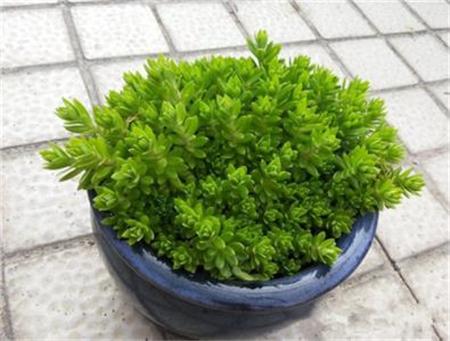
0
0
文章
张祥明
2018年02月03日


一、春季光照不足
1.原因:在春天季节,阳光较少,而这种花喜欢阳光充足的环境,如果我们把它长时间放在室内光线阴暗的地方,这会导致它不出现花蕾,从而不开花。
2.措施:特别是在春季阳光不充足的时候,我们最好把它放到阳台或者是院子里晒晒太阳。

二、夏季水分不足
1.夏季水分较少:在相对湿润的条件下它的生长比较茁壮,所以我们要需要保持土质偏湿,如果水分太少,就不能满足其基本生长的需求量,会导致它不开花。
2.夏季水分过多:我们在养殖的过程中要注意夏季的水量是否适宜,还有,我们要记住一点,一定不能让它淋到雨水。

三、秋季修枝方法不当
1. 原因:当枝叶过于繁茂时,它的叶子会吸收大量的养分,这本应该被花吸收的养分消失以后,就会导致植物不开花。
2.措施:我们要对多余的枝条进行定期的修剪。我们要选择剪去那些残败瘦弱的枝条、过于生长的枝条。

四、冬季空气不流通
1. 原因:虽然它能在在湿润的条件中生长良好,但是当室内通风不顺,会导致土壤中的水气过重,无法快速蒸发,从而它的土壤湿度得不到调节,结花也会受到一定影响。
2.措施:要把海棠花放到通风的地方,尤其是冬季的时候,要注意光照和通风。
0
1
文章
权问薇
2018年02月02日

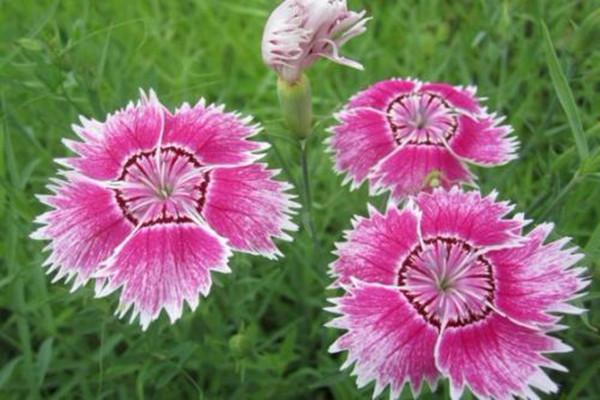
1.准备种子
等到它花谢后,就会结出来很多的种子,我们等到这些种子长熟之后,就可以将它们采收下来,然后放在水里面泡上半个小时,这样就可以促进后期种子的发芽。
2.准备播种的花盆和土壤
在种之前,我们要先准备好一个花盆,花盆选好了之后,就可以在里面放上一些土了,放的土一定要满足种子的生长需要,一般都是选择一些土质疏松、透气好的土壤,这样种子才能更容易发芽。

3.播种的时间
播种的话,还要把时间选择好了,合适的时间对它种子的成活也是有很大影响的。一般都是选择在春季或是秋季的时候把它直接种在盆里面。但是有一些寒冷的地区的话,在播种的时候要注意一下了,一般是不能直接种在盆土里面的,都是选择种在冷床或温床上面,这样种子才会更容易成活。
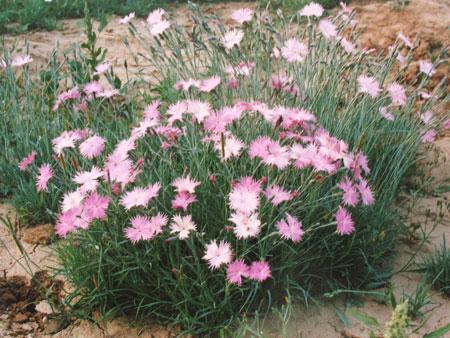
4.播种
我们将准备好的种子依次的放在容器里面,放的时候要注意一下,不可以太使劲的放,只需要慢慢的放到上面就可以,这样更加利于种子发芽。种子种好之后,我们就可以再用一些薄土撒在上面,给种子保温一下,然后再适当的浇上一点水,浇水的时候,最好把水浇透了,之后几天就不可以再浇水了。水浇好了之后,只要你温度控制的合适,一般只要十来天种子就会发出小芽了。
5.后期的养护
等到种子长出小芽之后,我们就要给它喷上一些除菌的药物,之后再隔上三四天,再给它喷上一次,然后等到小芽长出来4到5片的叶子时,我们就可以将它分别移栽到较大的盆子里了,这样可以方便小芽更快长大。
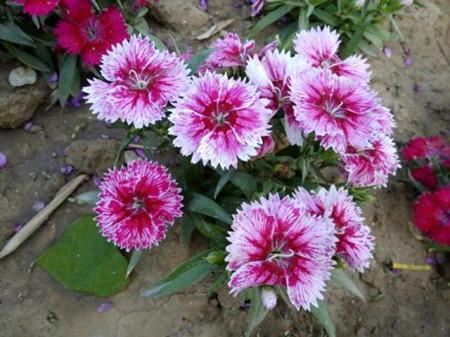
0
0
文章
权问薇
2018年02月02日


一、准备工作
1.选择种植方法:常规的种植方法有种子播种和扦插。一般来说,我们以种子播种为主要播种方法。
2.选择种植季节:我们一般选择在五月中期。因为播种八宝景天最适宜的温度在二十二摄氏度左右,所以如果我们能够避开多雨季节,会使八宝景天的种子成活率提高。
3.整地准备:即使八宝景天对土壤环境要求不苛刻,但播种前,我们也要将土地平整好。在种植前,我们应该先除去地表上的杂草和土壤中的砖头,再用大水浇灌透一次,最后我们再将土整平。
4.种子的摘取:我们选择几株八宝景天,小心慢慢摘取八宝景天的种子。收集之后,我们还要把种子放置在阴凉处两天,等待种植。
二、操作步骤
1. 间隔播种:随着八宝景天的幼苗的增长,它的幼芽越来越多,八宝景天的整体也随之增大。
2.添加土质:把配好的基质装入盘内,高度大约低于盆中三厘米。
3.播种:我们等待种植八宝景天的土被水渗透,可以把八宝景天的种子均匀地撒在土层的表面。
4.覆土:覆盖已经筛过的细土,细土厚度以模糊看见种子为准。
4.保温:我们可以用软枝条做出圆形拱架,在上面覆盖塑料薄膜,并沿拱架四周绑紧。
三、后期养护
1.浇灌:播种后,我们要及时喷洒水雾。
2.撤网:当八宝景天种子长出幼根后,我们就可以去掉遮阳网,保持土壤干燥。
3.剪枝:在第二年春季,我们要剪除地表顶部枯枝。
4.换床:当播种的八宝景天幼苗长到五厘米时,我们可以选择把八宝景天换床,把它移植到温室中。
5.分株:为了加大八宝景天的单位面积的营养,我们可以每三年分八宝景天一次,对八宝景天的生长有利。
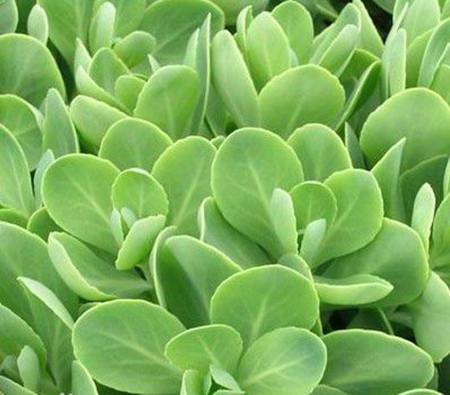
四、注意事项
1.光照:八宝景天喜欢强光照射,所以要有充足的光照。
2.温度:八宝景天在晚上生长的温度在十六摄氏度,在白天生长的温度在二十二摄氏度。
3.除草:我们要及时松土、除草。
1
1
文章
Miss Chen
2018年02月02日

Description: This wildflower is a biennial or short-lived perennial plant that is ½–1' tall when it blooms. The basal leaves persist during most of the year, although they may die down during the winter. They are ¾-2" long, ½-1" across, broadly elliptic to oval-obovate in shape, and either finely serrated or slightly dentate along their margins. The slender petioles of the basal leaves are ½-1" long and light green; they often have cobwebby hairs. The blade surface of the basal leaves is medium green and sparsely covered with mealy hairs. Unbranched flowering stalks develop among the basal leaves. These stalks are light green, terete to slightly channeled, and more or less covered with cobwebby hairs. Alternate leaves are sparsely distributed along each flowering stalk; they are up to 1¼" long and ¼" across. The alternate leaves are medium green, narrowly pinnatifid, and more or less covered with cobwebby hairs, particularly along the lower side of their central veins and along their petioles.
The central stalk terminates in a flat-headed cluster of 3-12 flowerheads. Each daisy-like flowerhead is about ½" across, consisting of 8-14 ray florets surrounding numerous disk florets that are yellow or golden yellow. The petaloid rays of the flowerheads are yellow and narrowly oblong. Around the base of each flowerhead, there are light green floral bracts (phyllaries) that are arranged together in a single series. They are oblong-linear in shape and more or less covered with cobwebby hairs. The blooming period occurs from mid- to late spring, lasting about 3-4 weeks. The flowerheads are mildly fragrant. About a month after the blooming period, the achenes mature, developing tufts of white hairs; they are dispersed by the wind. The root system is fibrous and rhizomatous. Prairie Ragwort often forms clonal colonies from its rhizomes.

Cultivation: The preference is full sun, mesic to dry conditions, and soil containing loam, clay-loam, sand, or gravelly material. Prairie Ragwort tends to favor less fertile soil because of the reduced competition from other plants. The basal leaves are semi-evergreen and they have few problems with disease.
Range & Habitat: The native Prairie Ragwort occurs primarily in the northern half of Illinois and in counties that are located along major rivers. It is occasional to locally common in the northern and western sections of the state, while elsewhere it is uncommon or absent (see Distribution Map). Habitats include upland prairies, gravel prairies, sand prairies, hill prairies, bluffs overlooking major rivers, openings in either rocky or sandy upland forests, sandy savannas, limestone glades, and roadside embankments. This little plant is usually found in open grassy areas. It blooms during the spring before the warm-season prairie grasses have achieved much growth.

Faunal Associations: Flies and small bees are the most common visitors to the flowers. Among the bee visitors, are little carpenter bees (Ceratina spp.), cuckoo bees (Nomada spp.), Halictid bees (Augochlorella spp., Halictus spp., Lasioglossum spp.), and Andrenid bees (Andrena spp.), including the oligolectic bee Andrena gardineri. Other floral visitors include Syrphid flies, Tachinid flies, thick-headed flies, skippers, and small butterflies. These insects are attracted to the nectar and pollen of the flowers. Polyphagous caterpillars of the moth Orthonama obstipata (The Gem) feed on the foliage of ragworts (Packera spp.); this moth dies out in Illinois during the winter, but it rapidly repopulates the state from the south when warm weather returns. Ragworts are preferred host plants of the seed bug, Neacoryphus bicrucis. The foliage is highly toxic to mammalian herbivores, especially cattle, and to a lesser extent horses and sheep. It contains pyrrolizidine alkaloids that can damage the liver and cause other health problems.

Photographic Location: The photographs were taken at Meadowbrook Park in Urbana, Illinois.
Comments: This is a perky little plant with bright yellow flowerheads. Among the various ragworts (Packera spp.) in Illinois, Prairie Ragwort is the most drought tolerant. It also has more cobwebby hairs on its flowering stalks and leaves than other ragworts, although these hairs gradually disappear after the blooming period. A scientific synonym of Prairie Ragwort is Senecio plattensis. The 'ragwort' in the common name probably refers to the ragged appearance of alternate leaves on the flowering stalks.
The central stalk terminates in a flat-headed cluster of 3-12 flowerheads. Each daisy-like flowerhead is about ½" across, consisting of 8-14 ray florets surrounding numerous disk florets that are yellow or golden yellow. The petaloid rays of the flowerheads are yellow and narrowly oblong. Around the base of each flowerhead, there are light green floral bracts (phyllaries) that are arranged together in a single series. They are oblong-linear in shape and more or less covered with cobwebby hairs. The blooming period occurs from mid- to late spring, lasting about 3-4 weeks. The flowerheads are mildly fragrant. About a month after the blooming period, the achenes mature, developing tufts of white hairs; they are dispersed by the wind. The root system is fibrous and rhizomatous. Prairie Ragwort often forms clonal colonies from its rhizomes.

Cultivation: The preference is full sun, mesic to dry conditions, and soil containing loam, clay-loam, sand, or gravelly material. Prairie Ragwort tends to favor less fertile soil because of the reduced competition from other plants. The basal leaves are semi-evergreen and they have few problems with disease.
Range & Habitat: The native Prairie Ragwort occurs primarily in the northern half of Illinois and in counties that are located along major rivers. It is occasional to locally common in the northern and western sections of the state, while elsewhere it is uncommon or absent (see Distribution Map). Habitats include upland prairies, gravel prairies, sand prairies, hill prairies, bluffs overlooking major rivers, openings in either rocky or sandy upland forests, sandy savannas, limestone glades, and roadside embankments. This little plant is usually found in open grassy areas. It blooms during the spring before the warm-season prairie grasses have achieved much growth.

Faunal Associations: Flies and small bees are the most common visitors to the flowers. Among the bee visitors, are little carpenter bees (Ceratina spp.), cuckoo bees (Nomada spp.), Halictid bees (Augochlorella spp., Halictus spp., Lasioglossum spp.), and Andrenid bees (Andrena spp.), including the oligolectic bee Andrena gardineri. Other floral visitors include Syrphid flies, Tachinid flies, thick-headed flies, skippers, and small butterflies. These insects are attracted to the nectar and pollen of the flowers. Polyphagous caterpillars of the moth Orthonama obstipata (The Gem) feed on the foliage of ragworts (Packera spp.); this moth dies out in Illinois during the winter, but it rapidly repopulates the state from the south when warm weather returns. Ragworts are preferred host plants of the seed bug, Neacoryphus bicrucis. The foliage is highly toxic to mammalian herbivores, especially cattle, and to a lesser extent horses and sheep. It contains pyrrolizidine alkaloids that can damage the liver and cause other health problems.

Photographic Location: The photographs were taken at Meadowbrook Park in Urbana, Illinois.
Comments: This is a perky little plant with bright yellow flowerheads. Among the various ragworts (Packera spp.) in Illinois, Prairie Ragwort is the most drought tolerant. It also has more cobwebby hairs on its flowering stalks and leaves than other ragworts, although these hairs gradually disappear after the blooming period. A scientific synonym of Prairie Ragwort is Senecio plattensis. The 'ragwort' in the common name probably refers to the ragged appearance of alternate leaves on the flowering stalks.
0
0






